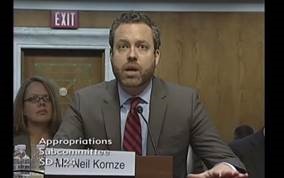Murkowski Rails Against New BLM Land Blocks in Alaska
Senator Lisa Murkowski today told the head of the Bureau of Land Management that Alaskans are “feeling burned” by his agency steadily withdrawing more and more land from Alaskans for potential development. The far-reaching impacts of the Area of Critical Environmental Concern (ACEC) designation – like the BLM proposing to block nearly 700,000 acres to mining within Interior Alaska’s Fortymile District – and the recently-introduced Bering Sea-Western Interior Area Plan are in defiance of the “No More” clause within the Alaska National Interest Lands Conservation Act, which clearly states that federal agencies are not allowed to study lands for conservation system units unless Congress has specifically authorized it.
Earlier this year, the BLM proposed designating 685,000 acres within the Fortymile mining district as an ACEC under the revised management plan for the region covering Interior Alaska. BLM claimed the withdrawal is necessary to protect habitat for local wildlife, even though it has successfully coexisted with local mineral production for decades. The 700,000 acres is the largest ACEC designation in the country, and is far bigger than what would be necessary to protect the calving area for the Fortymile caribou herd.
In today’s hearing of the Senate Interior Appropriations Subcommittee, Chairman Murkowski vocalized her frustration – and that of Alaskans statewide – saying ACECs and moves like them have the potential to make Alaskans “think of the Endangered Species Act and Critical Habitat designation as chump change.”
She told BLM Director Neil Kornze:I know I sound apocalyptic…but you have to appreciate the frustration, the anxiety. We felt that we had in place laws that are specific and unique to Alaska. Alaska is the “A” in ANILCA. And we thought we had a pretty good understanding as to what the “no more” clause meant. And yet what we’re finding now is that our federal agencies are coming up with changes in semantics, basically, to get around what was clearly a well-defined law … So it seems like any way you slice it, any term you want to call it, what it ends up being is withdrawal, restriction, and an inability of a state and a people to access resources that we were promised at statehood. So we’re feeling a little burned.
Earlier this year, Murkowski asked the BLM to eliminate completely or at least greatly reduce the size of its proposed ACEC withdrawal, to consult with Fortymile miners about the management of their region, and to significantly reduce – not increase – the regulatory burden being imposed on placer miners.
So far, no reduction has happened.
Locking In on Alaskan Concerns
Senator Murkowski used the appearance of Neil Kornze to focus on a number of Alaska concerns, like:
Contaminated Lands
Kornze noted that in working with the State of Alaska, he found that of the 6,000 contaminated sites in Alaska, 900 were on conveyed lands. He added that 2/3rds of those sites were either cleaned up or in the process of being cleaned up. Of the 300 sites remaining to be cleaned, a majority of those were originally Department of Defense or belonging to other federal agencies.
Senator Murkowski had a productive exchange with Kornze about the problem of contaminated land conveyed from the federal government to Alaska Native Corporations – asking what progress has been made on identifying how many acres still need to be restored.Kornze noted that in working with the State of Alaska, he found that of the 6,000 contaminated sites in Alaska, 900 were on conveyed lands. He added that 2/3rds of those sites were either cleaned up or in the process of being cleaned up. Of the 300 sites remaining to be cleaned, a majority of those were originally Department of Defense or belonging to other federal agencies.
Kornze then suggested that BLM may not be the best agency, saying he wanted to talk with Murkowski about “whether or not BLM is the best agency, because part of what you need is an agency that can compel action when it comes to clean up. Perhaps the EPA, or the State of Alaska working with EPA would be in the best position moving forwards.”
Legacy Wells
Murkowski also discussed the issue of legacy wells, asking how much of an impact was being made by the $50 million she was able to secure for clean up through the helium bill. She noted that work was just finished at the Umiat well site this past month, but said that the BLM needs to develop a focus and a plan for how it would handle the remaining clean up.
Kornze responded that the $50 million was able to address the Umiat clean up process, as well as future activities in Barrow and the Simpson Peninsula in legacy well clusters over the next two or three years – but that the funding from that one time allocation would likely run out at that point. Though Kornze did not give a direct answer to the funding source, he admitted that BLM would have to get more creative in dealing with additional sites because of the geographical distances between them.










